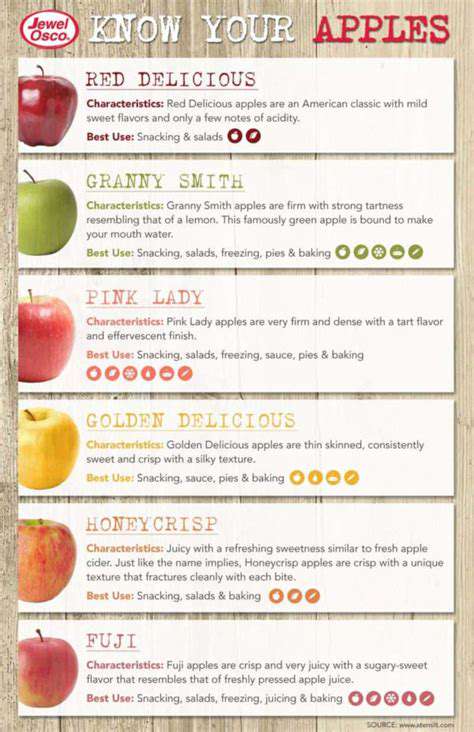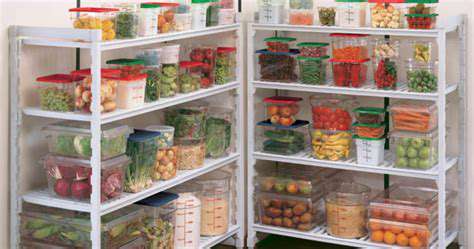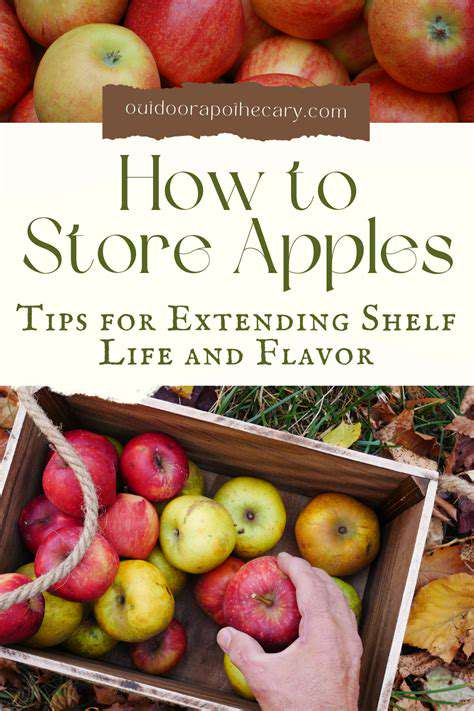How to Store Apples: Keep Them Crisp
Jun 16, 2025 / btwgardenmachine/
Choosing the Right Apples for Storage

Selecting Apples for Long-Term Storage
When planning to store apples for extended periods, picking the appropriate varieties makes all the difference. Not all apples are created equal when it comes to shelf life - some maintain their texture and flavor far longer than others. The key lies in understanding each variety's unique properties. Look for apples with thick skins and dense flesh, as these tend to resist softening over time. Before storing, conduct a thorough inspection of each fruit, rejecting any with blemishes, soft spots, or signs of damage.
Proper selection begins at harvest time. Apples picked at optimal ripeness store best - they should be firm to the touch but not rock hard. The stem should remain intact, as broken stems create entry points for decay. Size matters too; medium-sized apples typically store better than very large ones. When choosing between varieties, consider that late-season apples generally have better keeping qualities than early-season types.
Storage Conditions for Optimal Flavor
Creating the perfect storage environment requires attention to several factors. First and foremost is temperature control. A steady temperature just above freezing (32-35°F) dramatically slows the ripening process. This cold environment reduces the fruit's metabolic activity, preserving both texture and taste. However, freezing must be avoided as it damages cell structure, resulting in mushy apples when thawed.
Humidity management is equally critical. The ideal relative humidity for apple storage falls between 90-95%. This high moisture level prevents shriveling while still being low enough to discourage mold growth. Simple solutions like placing a damp cloth in the storage area or using perforated plastic bags can help maintain this balance. Regular monitoring is essential, as conditions can change with weather fluctuations.
Variety Selection for Maximum Longevity
Experience shows that certain apple varieties consistently outperform others in storage tests. Traditional storage champions include Fuji, Granny Smith, and Pink Lady, which can maintain quality for six months or more under ideal conditions. These varieties share traits like thick skins, high acidity, and firm flesh. In contrast, popular eating varieties like Gala or Red Delicious rarely last beyond two months, even with perfect storage.
When preparing apples for storage, handle them like delicate treasures. Never toss apples into containers - instead, place them gently to avoid bruising. Arrange them in single layers with adequate spacing to allow air circulation. Some veteran apple storers wrap each fruit in tissue paper to prevent contact between apples, a technique that can significantly extend shelf life.
Optimizing Your Apple Storage Environment
Choosing the Right Storage Location
Finding the perfect spot for apple storage requires balancing several factors. Basements often provide excellent conditions, offering both cool temperatures and stable humidity. However, any space that maintains consistent coolness without freezing can work. Avoid areas near appliances that generate heat, including water heaters or furnaces, as temperature fluctuations accelerate spoilage.
For those without cellar space, creative solutions exist. An unheated garage (in cold climates) or even a spare refrigerator can serve well. The critical factor is stability - daily temperature swings of more than a few degrees will shorten storage life. Insulating your storage area with straw bales or foam panels can help maintain consistency.
Controlling Humidity Levels
Managing moisture in your storage area requires vigilance. Simple hygrometers, available at hardware stores, allow precise humidity monitoring. If humidity drops too low, placing pans of water or damp burlap sacks nearby can help. For excess humidity, improve ventilation or add moisture-absorbing materials like unscented clay kitty litter in breathable containers.
Traditional storage methods offer proven solutions. Root cellars naturally maintain high humidity through their earth walls. Modern alternatives include specially designed refrigerator crispers with humidity controls. Whatever system you choose, remember that different apple varieties may prefer slightly different humidity levels, so grouping similar varieties together yields best results.
Proper Handling and Storage Techniques
The way you store apples affects their longevity as much as the storage environment itself. Wooden crates or cardboard boxes with ventilation holes allow ideal air flow. Avoid plastic bags unless they're specifically designed for produce storage with micro-perforations. When layering apples, separate them with clean straw or shredded paper to minimize contact points.
Regular inspections form a crucial part of successful storage. Check stored apples weekly, removing any showing signs of spoilage immediately. One bad apple truly can spoil the bunch, as rot spreads quickly in storage. Keep a record of when different varieties were stored, as their shelf lives will vary. This helps prioritize which to use first.
Understanding Ethylene Gas and its Impact
This natural plant hormone presents both challenges and opportunities in apple storage. Apples themselves produce ethylene, which accelerates ripening in nearby fruits. For longest storage, isolate apples from other produce. However, if you want to speed up ripening of other fruits, placing an apple nearby can help. Commercial storage facilities often use ethylene scrubbers to remove this gas from the air.
Some apple varieties produce more ethylene than others. Generally, sweeter varieties generate more gas than tart ones. Understanding this can help when planning storage arrangements. Keeping high-ethylene producers separate from more sensitive varieties can prevent premature ripening throughout your stored crop.
Proper Handling and Preparation for Storage

Proper Cleaning Techniques
Pre-storage preparation begins with careful cleaning. While washing removes surface dirt, excessive moisture can promote spoilage during storage. A better approach is dry cleaning - gently brushing off any visible dirt with a soft cloth or brush. This removes debris while keeping the natural protective wax layer intact. For organic apples or those with visible residues, a quick dip in diluted vinegar solution followed by thorough drying works well.
Sanitizing storage containers proves equally important. Wooden crates benefit from a bleach solution rinse (1 tablespoon bleach per gallon of water) followed by complete drying. Plastic containers should be food-grade and free from odors that might transfer to the apples. Always allow cleaned containers to air dry completely before use to prevent introducing moisture to your stored fruit.
Temperature Control During Preparation
The transition from harvest to storage demands careful temperature management. Apples should cool gradually to storage temperature - rapid chilling can cause condensation and subsequent spoilage. If harvesting on a warm day, allow apples to cool in a shaded, well-ventilated area before moving them to cold storage. This gradual cooling prevents thermal shock that can damage fruit cells.
For those processing large quantities, staging areas with intermediate temperatures help acclimate the fruit. Move apples from harvest temperature to 50°F for a day, then to 40°F before final storage at 32-35°F. This stepped approach minimizes stress on the fruit and preserves quality. Always handle apples gently during these transfers to avoid bruising.
Avoiding Cross-Contamination
Sanitation extends beyond the apples themselves to the entire storage environment. Never store apples near potatoes or onions, as these can transfer odors and hasten spoilage. Similarly, keep apples away from areas where chemicals are stored, as they readily absorb foreign odors. Designate apple-only storage spaces whenever possible to prevent unintended interactions.
When handling apples during storage rotation, clean hands or food-grade gloves prevent microbial transfer. Any tools used for handling should be sanitized regularly. This includes brushes for cleaning, sorting tables, and even the buckets or baskets used for transport. Consistent cleanliness practices significantly extend storage life.
Preventing Spoilage and Maintaining Crispness
Proper Storage Temperature
The science of apple storage confirms that temperature precision matters. Even a few degrees above optimal can shorten shelf life dramatically. Invest in a reliable thermometer to monitor your storage area continuously. Digital models with high/low memory functions help track temperature fluctuations that might otherwise go unnoticed.
In home refrigerators, the crisper drawer often provides the most stable environment. However, be aware that refrigerator temperatures typically cycle, which isn't ideal. For serious storage, consider a dedicated refrigerator with its thermostat adjusted to maintain a constant 33°F. This small investment pays dividends in extended apple quality.
Choosing the Right Storage Container
Container selection significantly impacts preservation success. Perforated plastic bags offer an excellent compromise, maintaining humidity while allowing some air exchange. These can be homemade by punching small holes in clean plastic bags or purchased as specialty produce storage bags. The goal is to prevent dehydration without creating a sealed, moisture-trapping environment.
For bulk storage, wooden crates with slatted sides promote optimal air circulation. Line them with clean straw or perforated liners to cushion the fruit. Avoid deep containers that would require stacking apples, as the weight crushes lower layers. Instead, use multiple shallow containers that allow single-layer storage with minimal fruit contact.
Effective Handling and Placement
How you arrange apples in storage affects their longevity. Storing apples stem-side down helps prevent stem punctures that lead to rot. This orientation also takes advantage of natural fruit geometry, creating small air channels between apples. For varieties prone to scald (a storage disorder causing brown patches), individual wrapping in oiled paper provides effective protection.
Rotate your stock regularly, using the first in, first out principle. Mark boxes with storage dates to track apple age. When removing apples for use, inspect the entire container and remove any showing early signs of deterioration. This proactive approach prevents small problems from affecting the entire batch.
Selecting the Right Apple Variety
Modern apple breeding has produced many excellent storage varieties beyond the classics. Newer cultivars like Jazz or SweeTango offer both great flavor and good storage potential. When planning your orchard or purchases, prioritize varieties known for storage if long-term keeping is important. Some heritage varieties, though less common, possess exceptional keeping qualities developed before refrigeration was available.
Remember that storage potential varies by growing region and season. Apples grown in cooler climates often store better than those from warmer areas. Similarly, a dry harvest season typically yields better-storing fruit than a wet one. These factors should inform your storage expectations and timelines.
